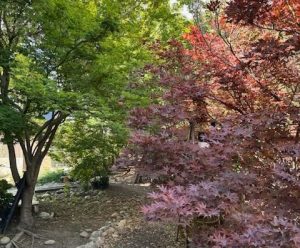When the sun dips behind the foothills and the day’s heat finally relents, a different kind of garden magic begins. The buzzing of bees fades and butterflies settle in for the night, and an unseen world awakens flowers that open only under the cloak of darkness, blooms that release their heady scents, and pollinators that work the night shift.
We humans might call it a “moon garden,” but the plants and pollinators that do their dance after dark call it home.
Pollinators of the Night
Moths are the star pollinators after dark, particularly the sphinx moth, also known as hawk moth or hummingbird moth. These large, fast-flying insects are drawn in to hover over flowers like hummingbirds, using their long proboscis to sip nectar from deep within the blooms.
While less common, some bats also play a role. Most bats in our area are insectivores, but species like the pallid bat, California’s official state bat, are omnivores that have been observed to consume fruit and nectar. However, bats’ primary role in this region is insect control, making moths a far more significant pollinator.
Plants That Draw the Moths
To entice these nocturnal pollinators, plants have evolved with characteristics like:
Pale or white flowers and silvery foliage: These colors are highly visible in low light conditions, such as moonlight.
Strong, sweet, often heady fragrances: These scents can travel long distances in the still night air, guiding pollinators to the flowers.
Tubular or trumpet-shaped flowers: These shapes are often ideal for pollinators with long proboscises (tongues), such as moths.
Here are some of the best examples of these plants:
Moonflower (Ipomoea alba): A classic choice, this annual vine (perennial in warmer parts of Zone 8) produces large, white, trumpet-shaped flowers that unfurl at dusk and release a strong, sweet scent. They close by morning.
Honeysuckle (Lonicera): Many honeysuckles are known for their sweet, heavy perfume, especially in the evening. Look for specific fragrant cultivars.
Evening Primrose (Oenothera): This biennial or perennial plant produces delicate, bowl-shaped flowers that open at dusk and emit a mild lemon scent.
Night Phlox (Zaluzianskya ovata): A low-growing perennial with small, star-shaped flowers that release a vanilla-like scent with hints of honey and marzipan at night.
Tuberose (Polianthes tuberosa): Known for its incredibly strong, sweet, and exotic fragrance, this bulbous perennial produces spikes of waxy, white, tubular flowers that are most fragrant at night.
Gardenia (Gardenia jasminoides): While often thought of as day-scented, gardenias actually intensify their famously rich, sweet fragrance at night to attract their moth pollinators.
Mock Orange (Philadelphus coronarius): This classic shrub produces abundant clusters of pure white, often citrus-scented flowers in late spring to early summer.
The relationship between these flowers and their pollinators is a delicate dance. The flowers provide a critical food source, and in return, the nocturnal creatures ensure the plants can reproduce and thrive, completing a cycle of life that is often hidden from our view. By planting a moon garden with these special flowers, you can support this vital ecosystem and experience the magic of the garden after dark.
Rachel Oppedahl is a UCCE Tuolumne County Master Gardener of Tuolumne County.

